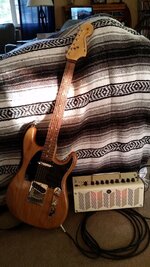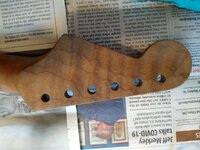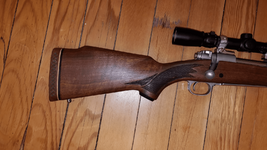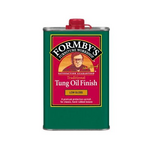- Messages
- 783
- Reactions
- 511
Follow along with the video below to see how to install our site as a web app on your home screen.
Note: This feature may not be available in some browsers.



Do not confuse Tung Oil with varnish. Big, big difference.
Also, do not confuse Tung Oil with Teak Oil, which is not made from teak but a whole bunch of chemicals.
I don't care for how Tung Oil smells, but LOVE how it looks.
Though Tung oil is a wood finish, you can regard it more like a stain since it's absorbed by the wood.
After using Tung oil, you can apply varnish. I wouldn't try the reverse.
If you're refinishing wood, be sure to strip off all the old varnish/shellac or whatever the finish is.
Like @Koda suggests, do at least four coats. Makes a huge difference, and you see it in the weather resistance of the finish.
Like with stain (though some may disagree), your bare wood shouldn't be sanded too finely (i.e. sand up to 240 grit, but not more).
Thin the tung oil for your first coat (I'll do 50:50 with mineral spirits or turpentine). The last one I did with turpentine. You can reapply in ~4 hours but I let my first application dry overnight. Lots of drips while applying is not uncommon, so protect your work surface.
Before your next application, you can rub with clean 0000 steel wool. I say clean because I've had some right out of the package that had oil in the steel, and left a dark shadow -- a WTH moment. To ensure, I'll soak my steel wool in xylene and then let dry.
I highlighted can because, after only a night of drying, the Tung oil is still pretty oily. I use dust free lab wipes to wipe it off (no lint or dust), and then apply another coat.
I apply liberally with a trash staining brush, not something you do with varnish. Wait 4 - 6 hours and then wipe off. Let dry overnight, preferably a warm, dry, dust free location. You can spray it on too, but I'm too lazy to clean my Binks so didn't bother.
When I did my last rifle stock, after the last coat, I put it away somewhere clean and safe for 6 weeks. It was dry to the touch when I pulled it out. I then pillar and glass bedded the action to the stock.
Varnish, on the other hand, is all about surface prep. You'll want to sand to at least 600 (have known folks to go to 1200) before your first coat and also between, before applying a thin coat. Spraying is best, and if brushed, the quality of brush makes a world of difference. On boats I've used the foam brushes (Good ones from Rockler - not the red handled crap from Dollar Tree/home depot) with lightly thinned varnish and it also works well. Toss the brush after each use.
Matte, satin or gloss varnish, if you want it to look like you're staring through water (i.e. a deep lustre), you want to apply at least four thin coats. After your last coat, you can do the same sanding routine as if you're going to apply another coat, but then follow with hand polishing using polishing grits.
[edit to add] With varnish, do not "stir" or shake the varnish. This entrains air bubbles. Also, move your brush or applicator slowly and deliberately so to not get any air bubbles in the varnish on application. If you do, and let it dry, these look like acne in the finish, even if the bubbles popped. [/edit]
Edit to add: because Tung oil is absorbed, you can lightly sand or scratch the wood and the finish color and lustre will remain the same.
Here's my Winnie M70 after Tung Oil. The stock was a thrashed, used one I picked up from @BanjoGeek. Much nicer than the tupperware the rifle was originally sitting in.
View attachment 778784
 Used many times -is a little sticky on your hands during use but clean up per instructions. Later when you feel the need to touch up the stock here-and-there it's easy as pie. No mixing no tinting - just rub some more in. Even though they sell varying levels of glossiness, I've found the finish gets glossier the more coats applied. Just stop applying when it looks the way you want.
Used many times -is a little sticky on your hands during use but clean up per instructions. Later when you feel the need to touch up the stock here-and-there it's easy as pie. No mixing no tinting - just rub some more in. Even though they sell varying levels of glossiness, I've found the finish gets glossier the more coats applied. Just stop applying when it looks the way you want.Homer Formbys Tung Oil - View attachment 778797 Used many times -is a little sticky on your hands during use but clean up per instructions. Later when you feel the need to touch up the stock here-and-there it's easy as pie. No mixing no tinting - just rub some more in. Even though they sell varying levels of glossiness, I've found the finish gets glossier the more coats applied. Just stop applying when it looks the way you want.
Yes you are correct (still like the product tho). I googled it and found they've been absorbed by Minwax: website had the following:Friend that is Tung Oil Finish. That IS NOT the same thing as tung oil. It is more like a varnish. I have successfully used it many times in my gunstock finishes.
Friend I wish you luck. I never could get pure tung oil to dry.